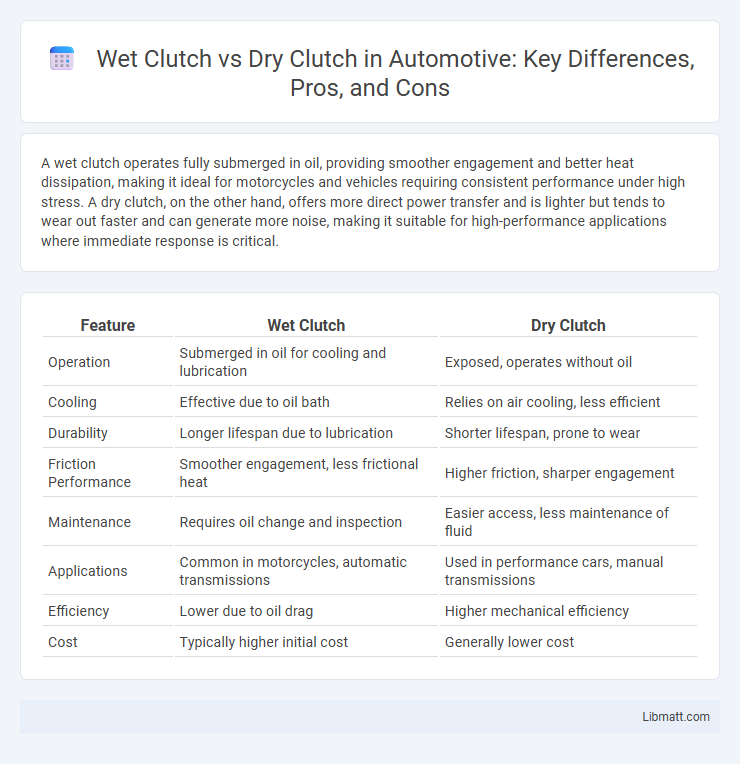A wet clutch operates fully submerged in oil, providing smoother engagement and better heat dissipation, making it ideal for motorcycles and vehicles requiring consistent performance under high stress. A dry clutch, on the other hand, offers more direct power transfer and is lighter but tends to wear out faster and can generate more noise, making it suitable for high-performance applications where immediate response is critical.
Table of Comparison
| Feature | Wet Clutch | Dry Clutch |
|---|---|---|
| Operation | Submerged in oil for cooling and lubrication | Exposed, operates without oil |
| Cooling | Effective due to oil bath | Relies on air cooling, less efficient |
| Durability | Longer lifespan due to lubrication | Shorter lifespan, prone to wear |
| Friction Performance | Smoother engagement, less frictional heat | Higher friction, sharper engagement |
| Maintenance | Requires oil change and inspection | Easier access, less maintenance of fluid |
| Applications | Common in motorcycles, automatic transmissions | Used in performance cars, manual transmissions |
| Efficiency | Lower due to oil drag | Higher mechanical efficiency |
| Cost | Typically higher initial cost | Generally lower cost |
Introduction to Wet Clutch and Dry Clutch Systems
Wet clutch systems use oil to lubricate and cool the clutch plates, providing smoother engagement and better heat dissipation, making them ideal for high-performance and heavy-duty applications. Dry clutch systems operate without oil, offering a more direct power transfer and lighter weight but generating more heat and wear. Understanding these differences helps you choose the right clutch system based on your vehicle's performance and durability needs.
How Wet Clutches Work
Wet clutches operate by immersing the clutch plates in a lubricating fluid, typically oil, which cools and reduces friction during engagement. This fluid layer allows for smoother power transfer and increased durability under high torque loads, especially in motorcycles and automatic transmissions. The continuous lubrication in wet clutches enhances heat dissipation and prevents premature wear compared to dry clutches.
How Dry Clutches Work
Dry clutches operate by using friction between a pressure plate and clutch disc to engage and disengage the engine from the transmission without the presence of lubricating oil. This design allows for quicker response times and higher torque capacity compared to wet clutches, which rely on oil for cooling and lubrication. Understanding how your dry clutch works helps in optimizing performance and maintenance, especially in high-performance or heavy-duty vehicles.
Key Differences Between Wet and Dry Clutches
Wet clutches operate immersed in oil, providing better cooling and smoother engagement, ideal for high-performance and heavy-duty vehicles. Dry clutches function without lubrication, offering more direct power transfer and higher efficiency but tend to wear faster and generate more heat. Your choice between wet and dry clutches should consider factors such as heat dissipation, maintenance frequency, and driving conditions to optimize performance and durability.
Performance Comparison: Wet vs Dry Clutch
Wet clutches offer superior heat dissipation and smoother engagement due to lubrication by oil, making them ideal for high-performance vehicles requiring durability and consistent friction management. Dry clutches provide more direct power transfer with less drag, resulting in quicker response times and increased efficiency, but may experience faster wear and overheating under heavy use. The choice between wet and dry clutches depends on balancing performance needs with maintenance preferences and vehicle operating conditions.
Maintenance Requirements for Wet and Dry Clutches
Wet clutches require regular fluid changes and inspections to maintain optimal performance, as they operate immersed in oil which helps with cooling and reduces wear. Dry clutches demand more frequent adjustments and replacements of friction materials due to higher heat exposure and faster wear without the cooling benefits of oil. Understanding these maintenance differences ensures your clutch system remains reliable and efficient over time.
Advantages of Wet Clutch Systems
Wet clutch systems offer superior cooling and durability due to their oil bath environment, which reduces heat and friction during operation. Their ability to provide smoother engagement and better performance under high torque loads makes them ideal for motorcycles and heavy machinery. You benefit from extended clutch lifespan and enhanced reliability with wet clutch designs compared to dry clutch counterparts.
Advantages of Dry Clutch Systems
Dry clutch systems offer superior heat dissipation due to the absence of oil, resulting in more consistent friction performance and reduced slipping under high loads. Their simpler design leads to lower maintenance requirements and easier inspection, enhancing reliability and longevity in demanding applications. Furthermore, dry clutches provide quicker engagement and more direct power transfer, benefiting performance-oriented vehicles and machinery.
Common Applications: Which Vehicles Use Which?
Wet clutches are common in motorcycles, ATVs, and high-performance vehicles due to their superior cooling and durability in continuous, high-torque conditions. Dry clutches are typically utilized in sports cars and some single-plate motorcycle models where quicker engagement and reduced drag improve performance efficiency. Your choice between wet and dry clutch systems should consider the specific vehicle type and driving conditions to ensure optimal performance and longevity.
Choosing the Right Clutch for Your Needs
Wet clutches, immersed in oil, offer superior cooling and smoother engagement, making them ideal for high-performance motorcycles and heavy-duty vehicles requiring durability and heat dissipation. Dry clutches provide a more direct power transfer and lighter weight, preferred in lightweight sports motorcycles and racing applications where quick response and minimal drag are essential. Selecting the right clutch depends on your vehicle's usage, performance expectations, and maintenance preferences to optimize efficiency and longevity.
Wet clutch vs Dry clutch Infographic

 libmatt.com
libmatt.com